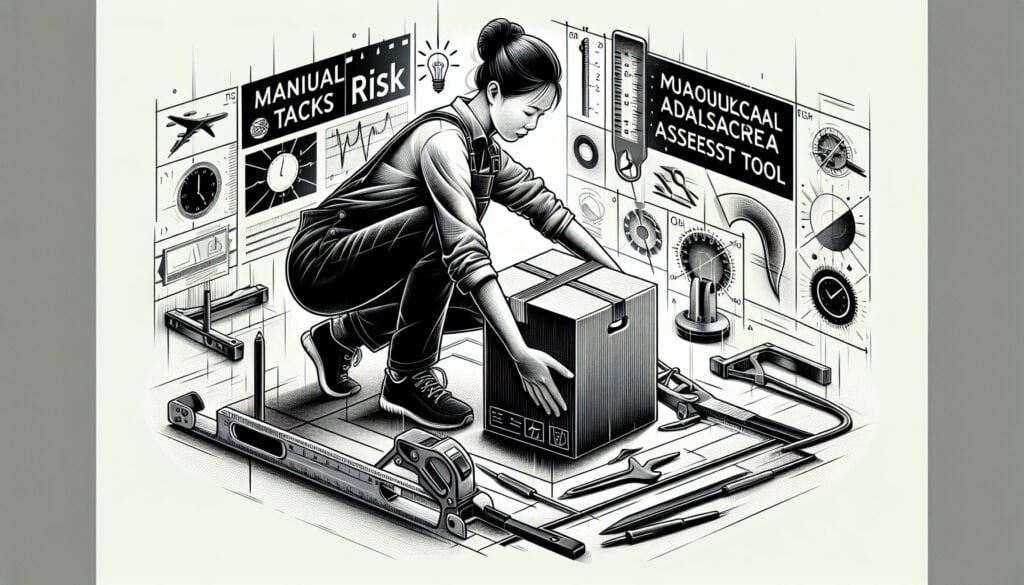تقييم مخاطر الاضطرابات العضلية الهيكلية الناتجة عن المهام اليدوية المختلفة.
- المنهجيات: بيئة العمل, الموارد البشرية, إدارة المخاطر
أداة تقييم مخاطر المهام اليدوية (ManTRA)

أداة تقييم مخاطر المهام اليدوية (ManTRA)
- التحسين المستمر, بيئة العمل, العوامل البشرية, هندسة العوامل البشرية (HFE), تحسين العمليات, إدارة الجودة, تحليل المخاطر, إدارة المخاطر, أمان
الهدف:
كيفية استخدامه:
- أداة تقييم المخاطر المريحة التي تقيّم مستوى المخاطر المرتبطة بمجموعة كبيرة من المهام اليدوية، وليس فقط الرفع. فهي تأخذ في الاعتبار عوامل مثل الوضعية والقوة والتكرار لتوفير درجة مخاطر شاملة.
الايجابيات
- أداة شاملة تغطي مجموعة متنوعة من المهام اليدوية؛ توفر نهجًا منظمًا لتقييم المخاطر.
سلبيات
- يمكن أن يكون استخدامه معقداً وقد يتطلب تدريباً؛ قد يستغرق التقييم وقتاً طويلاً.
الفئات:
- بيئة العمل, إدارة المخاطر
الأفضل لـ
- إجراء فحص تفصيلي التقييم المريح من الوظائف اليدوية ذات المهام المتنوعة والمعقدة.
تخدم ManTRA مجموعة واسعة من الصناعات، بما في ذلك التصنيع والرعاية الصحية والخدمات اللوجستية والبناء، حيث يقوم العمال في كثير من الأحيان يخطب في المهام اليدوية التي تشكل مخاطر مريحة. هذه الأداة قابلة للتطبيق خلال مرحلتي التخطيط والتنفيذ لإجراءات العمل، مما يسمح للمؤسسات بدمج التقييمات المريحة في تصميم مساحات العمل والممارسات. تبدأ هذه الأداة من قبل أخصائيي السلامة أو أخصائيي بيئة العمل أو مديري الصحة والسلامة، ولكن يجب أن يشارك فيها بنشاط العمال الذين يؤدون المهام التي يتم تقييمها، حيث يمكن أن توفر ملاحظاتهم معلومات لا تقدر بثمن فيما يتعلق بالتحديات العملية التي يواجهونها. يقوم ManTRA بتقييم جوانب متعددة من المهام اليدوية، مثل وضعية الجسم والإجراءات المتكررة وإجهاد القوة، مما يساعد المؤسسات على تحديد الأنشطة عالية الخطورة وتنفيذ التدخلات المستهدفة للتخفيف من المخاطر. من خلال توفير درجة شاملة للمخاطر، يمكن للمؤسسات تحديد أولويات الإجراءات بناءً على درجة الخطورة والاحتمال، مما يضمن معالجة أهم المشكلات أولاً. لا تساعد هذه المنهجية في الامتثال للوائح الصحة والسلامة المهنية فحسب، بل تساهم أيضًا في تحسين رفاهية العمال، وانخفاض معدلات الإصابات، وانخفاض معدلات التغيب عن العمل، وزيادة الإنتاجية، مما ينعكس إيجابًا على الكفاءة التشغيلية ومعنويات الموظفين. كما يسهل نهجها المنظم أيضًا إجراء مقارنات بين مختلف المهام والأدوار، مما يتيح إجراء تقييمات موحدة يمكن أن توجه صياغة السياسات وتعزز التحسين المستمر في بيئة العمل في مكان العمل. هذا تعدد الاستخدامات يجعل من ManTRA مورداً قيماً للمؤسسات التي تسعى جاهدةً لتعزيز سلامة العمال وتحسين تصميم المهام.
الخطوات الرئيسية لهذه المنهجية
- تحديد المهام التي يتم تقييمها، مع ضمان التركيز على مجموعة واسعة من الأنشطة اليدوية.
- قم بتحليل الوضعيات المطلوبة لكل مهمة، مع ملاحظة الوضعيات المحرجة التي قد تساهم في حدوث مخاطر.
- تقييم القوى المبذولة أثناء أداء المهام، وتحديد مستوى الحمل البدني الذي يتم التعامل معه.
- فحص تواتر ومدة الأنشطة التي يتم القيام بها، خاصة فيما يتعلق بالحركات المتكررة.
- تقييم بيئة العمل لتحديد أي عوامل قد تؤدي إلى تفاقم المخاطر المريحة.
- اجمع النتائج معًا لحساب درجة المخاطر الإجمالية، مع الإشارة إلى مستوى المخاطر المريحة لكل مهمة.
- وضع استراتيجيات للتخفيف من المخاطر التي تم تحديدها، بما في ذلك إعادة تصميم المهام أو توفير الوسائل المساعدة المريحة.
- تنفيذ التغييرات ومراقبة أداء المهام لضمان الامتثال المستمر للمعايير المريحة.
نصائح للمحترفين
- دمج ملاحظات المستخدمين في عملية تقييم المخاطر للتحقق من صحة النتائج وتكييف التدخلات بفعالية.
- استخدم تقنية التقاط الحركة المتقدمة لالتقاط بيانات الوضعية والحركة في الوقت الفعلي، مما يعزز الدقة في التقييمات.
- تنفيذ اختبار متكرر بعد التدخل لقياس فعالية التعديلات المريحة وضمان التحسين المستمر.
لقراءة عدة منهجيات ومقارنتها, نوصي باستخدام
> مستودع المنهجيات الشامل <
مع أكثر من 400 منهجية أخرى.
نرحب بتعليقاتكم على هذه المنهجية أو المعلومات الإضافية على قسم التعليقات أدناه ↓، وكذلك أي أفكار أو روابط متعلقة بالهندسة.
السياق التاريخي
1986
(إذا كان التاريخ غير معروف أو غير ذي صلة، على سبيل المثال "ميكانيكا الموائع"، يتم تقديم تقدير تقريبي لظهوره الملحوظ)

منشورات ذات صلة
حاسبة METS إلى السعرات الحرارية
التحليل التلوي
تخطيط الرسائل
مخططات النموذج الذهني
الحد الأقصى لقوى الدفع والسحب المقبولة
تخطيط الاحتياجات المادية (MRP)